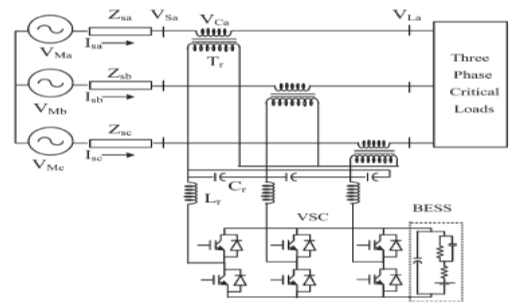Voltage unbalance and
harmonics compensation for
islanded microgrid inverters
ABSTRACT:
Voltage
source inverters (VSIs) are usually used for all kinds of distributed
generation interfaces in a microgrid. It is the microgrid’s superiority to
power the local loads continuously when the utility fails. When in islanded
mode, the voltage and frequency of the microgrid are determined by the VSIs;
therefore the power quality can be deteriorated under unbalanced and non-linear
loads. A voltage unbalance and harmonics compensation strategy for the VSIs in
islanded microgrid is proposed in this study. This method is implemented in a
single synchronous reference frame (SRF) and is responsible for both the
voltage unbalance and harmonic compensation. Furthermore, the virtual impedance
loop is modified to improve the compensation
effect.
The impedance model of the VSI is built to explain the compensation ability of
the proposed strategy. The whole control system mainly includes power droop
controllers, a modified virtual impedance loop and inner SRF-based voltage unbalance
and harmonics compensators. The proposed strategy is demonstrated in detail and
validated with simulations and experiments.
SOFTWARE: MATLAB/SIMULINK
BLOCK DIAGRAM:
Fig.
1 Schematic and control of DGs interface in an AC microgrid
a Typical AC microgrid structure with
DGs and loads
b Schematic of a VSI as the DG
interface
c Power droop control loop of DGs
interface
CONCLUSION:
This
paper proposes a FPS SRF-based control strategy for voltage unbalance and
harmonic compensation of the VSIs used as interfaces in islanded microgrid. The
voltage compensation loops are integrated within the power droop loops and the
virtual output impedance loop. The proposed strategy is implemented in a single
SRF with a PI controller for the voltage’s fundamental component regulation and
multi-resonant controller for voltage unbalance and selected harmonics compensation.
The impedance model of the DG interface inverter is built when controlled by
three different control methods to explain the compensation ability of the proposed
strategy, which are the conventional PI voltage controller, the PI plus
multi-resonant voltage controller and the PI plus multi-resonant voltage
controller with modified virtual impedance loop. The simulation and
experimental results of the three different control strategies with balanced
load, unbalanced load and diode bridge rectifier load are given to validate the
effectiveness of the proposed control strategy.
REFERENCES:
1
Lasseter, R.H.: ‘Certs microgrid’. IEEE Int. Conf. System of Systems Engineering,
2007 (SoSE ’07), 2007, pp. 1–5
2
Lasseter, R.H., Piagi, P.: ‘Extended microgrid using (DER) distributed energy
resources’. IEEE Power Engineering Society General Meeting, 2007, pp. 1–5
3
Rocabert, J., Luna, A., Blaabjerg, F., Rodri, X., Guez, P.: ‘Control of power
converters in AC microgrids’, IEEE Trans. Power Electron., 2012, 27, (11), pp.
4734–4749
4
Ming, H., Haibing, H., Yan, X., Guerrero, J.M.: ‘Multilayer control for inverters
in parallel operation without intercommunications’, IEEE Trans. Power
Electron., 2012, 27, (8), pp. 3651–3663
5
Guerrero, J.M., Blaabjerg, F., Zhelev, T., et al.: ‘Distributed generation: toward
a new energy paradigm’, IEEE. Ind. Electron. Mag., 2010, 4, (1), pp. 52–64





